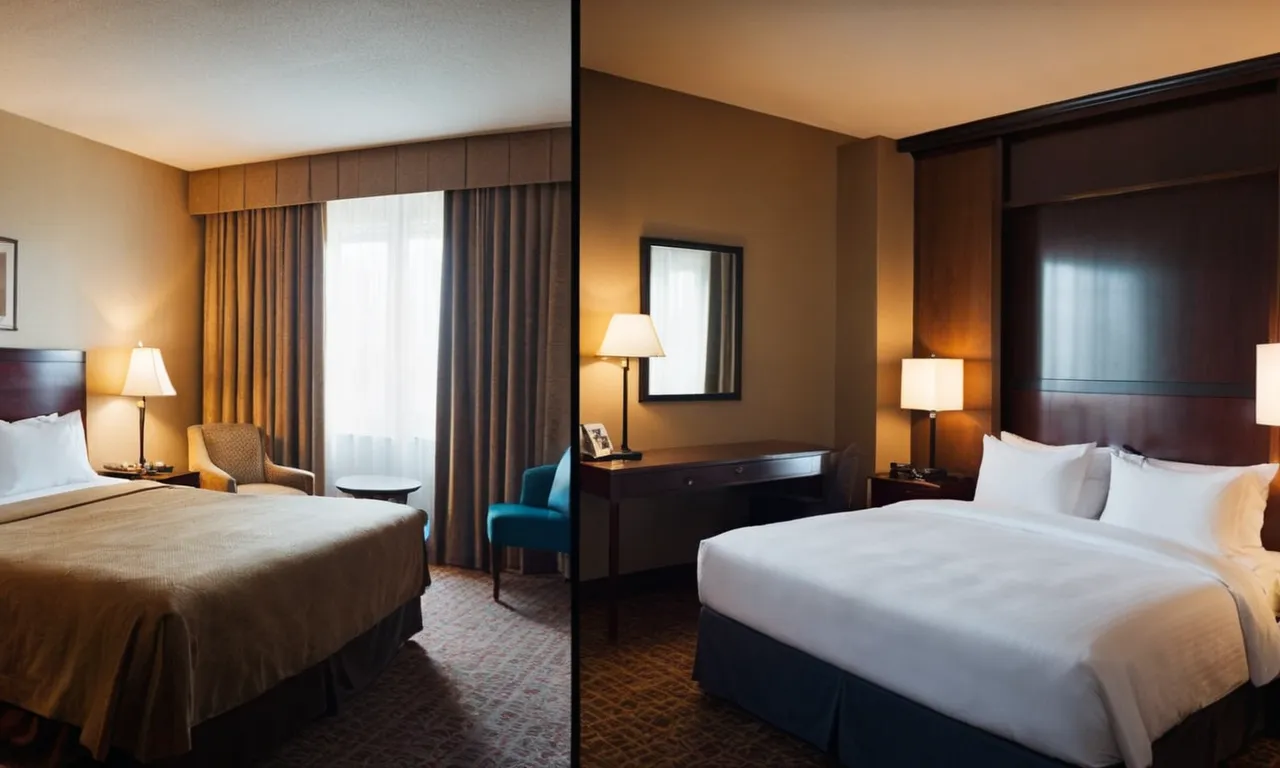Difference Between Per Night And Per Stay: A Comprehensive Guide
When it comes to booking accommodations, understanding the pricing structure is crucial to avoid any surprises or misunderstandings. Two common terms you’ll encounter are ‘per night’ and ‘per stay,’ but what exactly do they mean, and how do they differ?
If you’re short on time, here’s a quick answer to your question: Per night pricing refers to the cost of staying for a single night, while per stay pricing is a flat rate for the entire duration of your stay, regardless of the number of nights.
In this comprehensive article, we’ll delve into the nuances of these pricing models, explore their implications for travelers, and provide insights to help you make informed decisions when booking your next accommodation.
Understanding Per Night Pricing
Definition and Explanation
Per night pricing, also known as nightly rates or daily rates, is a common pricing model used in the hospitality industry, particularly for hotels, vacation rentals, and other short-term accommodation providers.
It refers to the practice of charging guests a fixed rate for each night they stay at the property. This pricing strategy is straightforward and easy to understand for both guests and property owners.
Under the per night pricing model, the total cost of a guest’s stay is calculated by multiplying the nightly rate by the number of nights they plan to stay. For example, if a hotel charges $100 per night and a guest books a three-night stay, the total cost would be $300 (3 nights x $100 per night).
This pricing approach allows guests to budget and plan their expenses more effectively, as they know exactly how much they’ll be paying for their accommodation upfront.
Advantages of Per Night Pricing
- Transparency and simplicity: Per night pricing is easy to understand for guests, making it a transparent and straightforward pricing model.
- Flexibility: Property owners can adjust nightly rates based on various factors, such as seasonality, occupancy levels, or special events, allowing for dynamic pricing strategies.
- Familiarity: Guests are familiar with the concept of paying per night, as it is a widely adopted practice in the hospitality industry.
- Competitive pricing: By comparing nightly rates across different properties, guests can easily find the best deals and make informed decisions.
Disadvantages of Per Night Pricing
- Potential for higher costs: For longer stays, the total cost can accumulate quickly, potentially making it more expensive than alternative pricing models.
- Lack of incentives for longer stays: Per night pricing may not incentivize guests to book longer stays, as there are typically no discounts or package deals offered.
- Inflexibility for guests: Guests may have to pay for nights they don’t fully utilize, such as early check-outs or late check-ins.
- Seasonality fluctuations: During high seasons or peak periods, nightly rates can skyrocket, making accommodation less affordable for some guests.
According to a study by Hotel News Resource, over 80% of hotels in the United States still use per night pricing as their primary pricing model, highlighting its widespread adoption and familiarity in the industry.
However, alternative pricing strategies, such as per stay or package deals, are gaining popularity among some properties to cater to different guest preferences and market demands.
Exploring Per Stay Pricing
Definition and Explanation
Per stay pricing, also known as flat rate pricing or package pricing, refers to a pricing model where guests pay a fixed amount for their entire stay, regardless of the number of nights. This approach differs from the more traditional per night pricing, where the cost is calculated based on the nightly rate multiplied by the number of nights.
Per stay pricing is commonly used in the hospitality industry, particularly for vacation rentals, resorts, and all-inclusive packages.
The core idea behind per stay pricing is to offer a bundled rate that covers the entire duration of the guest’s visit. This pricing strategy can be advantageous for both guests and property owners, as it provides transparency, simplicity, and potential cost savings.
For example, a property might offer a per stay rate of $1,000 for a week-long stay, which could be more appealing than paying a nightly rate of $200 multiplied by seven nights, totaling $1,400.
Advantages of Per Stay Pricing
- Simplicity and transparency: Per stay pricing eliminates the need for complex calculations and allows guests to understand the total cost upfront.
- Potential cost savings: In many cases, per stay pricing can offer guests a discounted rate compared to paying per night, especially for longer stays.
- Increased bookings: The perception of value and potential cost savings can attract more guests and lead to higher occupancy rates for properties.
- Flexibility: Property owners can adjust their per stay rates based on demand, seasons, or special promotions, providing more flexibility in pricing strategies.
Disadvantages of Per Stay Pricing
- Reduced flexibility for guests: With per stay pricing, guests may not have the option to adjust their stay length or check-in/check-out dates without incurring additional costs or penalties.
- Potential revenue loss: If guests depart early or shorten their stay, property owners may lose out on potential revenue compared to per night pricing.
- Complexity in revenue management: Determining optimal per stay rates can be challenging, as it requires careful analysis of demand patterns, seasonality, and market conditions.
- Limited appeal for shorter stays: Per stay pricing may not be as attractive for guests planning shorter stays, as the perceived value may be lower compared to per night pricing.
It’s worth noting that the decision to implement per stay pricing often depends on the specific property type, target market, and overall business strategy. Some properties may opt for a hybrid approach, offering both per night and per stay rates to cater to different guest preferences.
Additionally, platforms like Airbnb and Vrbo have embraced per stay pricing models, allowing hosts to set their own pricing strategies.
Factors Influencing Pricing Models
When it comes to pricing models for accommodations, several factors play a crucial role in determining whether a property opts for a per-night or per-stay approach. These factors can significantly impact the overall experience for guests and the revenue potential for the accommodation provider.
Let’s delve into the key considerations that shape these pricing strategies.
Accommodation Type
The type of accommodation is a pivotal factor in deciding the pricing model. Hotels and traditional resorts often favor a per-night pricing strategy, as it aligns with their operational model of offering short-term stays.
On the other hand, vacation rentals, such as Airbnb listings, tend to lean towards a per-stay pricing approach, catering to longer stays and providing a more home-like experience.
Location and Seasonality
The location and seasonality of a property can greatly influence its pricing strategy. For instance, accommodations in popular tourist destinations may opt for a per-night model during peak seasons to maximize revenue from short-term visitors.
Conversely, properties in less-traveled areas or those catering to extended stays might find a per-stay model more suitable, offering discounts for longer bookings. According to a study by Hotel News Resource, hotels in major cities like New York and San Francisco tend to have higher nightly rates, while those in smaller towns or rural areas often have more affordable per-night prices.
Amenities and Services
The range of amenities and services offered by an accommodation can also impact its pricing model. Hotels and resorts with extensive on-site facilities, such as restaurants, spas, and recreational activities, may prefer a per-night approach to account for the additional costs associated with maintaining these amenities.
On the flip side, vacation rentals or budget accommodations with fewer amenities may find a per-stay model more suitable, as it aligns with their focus on providing a simple, cost-effective lodging experience.
According to Statista, amenities like free Wi-Fi, laundry facilities, and fitness centers can significantly influence a guest’s decision to book a particular accommodation.
It’s worth noting that some accommodations may offer a combination of both pricing models, catering to different guest preferences and needs. For instance, a resort might offer a per-night rate for standard rooms and a per-stay rate for their vacation rental villas or suites.
Ultimately, the pricing model chosen should align with the property’s target market, operational costs, and overall business strategy. 😊
Choosing the Right Pricing Model
When it comes to booking accommodations, understanding the difference between per night and per stay pricing models is crucial. This choice can significantly impact your overall costs and experience. Whether you’re planning a short weekend getaway or an extended stay, the right pricing model can make all the difference in maximizing value for your money.
😎
Considerations for Short Stays
- For short stays, the per night pricing model is often the preferred choice. This model allows you to pay for each night you spend at the accommodation, making it more cost-effective for shorter trips.
- According to a study by Statista, 62% of travelers prefer hotels for short stays due to their transparent pricing and flexible cancellation policies.
- With per night pricing, you have the flexibility to adjust your stay duration without incurring additional costs or penalties. This can be particularly advantageous if your plans change unexpectedly.
Considerations for Extended Stays
- For extended stays, the per stay pricing model may offer better value. This model allows you to pay a flat rate for the entire duration of your stay, often resulting in significant savings compared to per night pricing.
- According to Hotel News Resource, the average daily rate for extended stays can be up to 30% lower than per night rates.
- Extended stay accommodations, such as serviced apartments or vacation rentals, frequently offer per stay pricing to cater to long-term guests. These accommodations often come equipped with amenities like kitchens and laundry facilities, making them ideal for longer stays.
Negotiating Rates and Discounts
Regardless of the pricing model you choose, it’s always worth exploring opportunities to negotiate rates and discounts. 💰 Many accommodations are willing to offer special deals or discounts, especially during low seasons or for extended stays.
- Don’t be afraid to inquire about discounts or package deals. You might be surprised at the savings you can unlock simply by asking!
- Consider joining loyalty programs or using travel booking platforms that offer exclusive member discounts. These can often provide significant savings on your accommodation costs.
- For extended stays, it’s worth negotiating a discounted rate upfront. Many accommodations are open to offering lower per stay rates for longer bookings, as it guarantees a steady stream of income for them.
By understanding the nuances of per night and per stay pricing models, and being proactive in negotiating rates, you can maximize the value of your accommodation and ensure a memorable and cost-effective stay, whether it’s for a short getaway or an extended vacation. 🎉
Conclusion
Understanding the difference between per night and per stay pricing is essential for travelers seeking to make informed decisions and maximize their budget. By considering factors such as the length of stay, accommodation type, and personal preferences, you can choose the pricing model that best suits your needs.
Remember, per night pricing offers flexibility and transparency, while per stay pricing can provide cost savings for longer stays. Ultimately, the choice depends on your specific travel requirements and priorities.
Whether you’re planning a short weekend getaway or an extended vacation, armed with the knowledge from this comprehensive guide, you’ll be better equipped to navigate the world of accommodation pricing and find the perfect fit for your next adventure.







